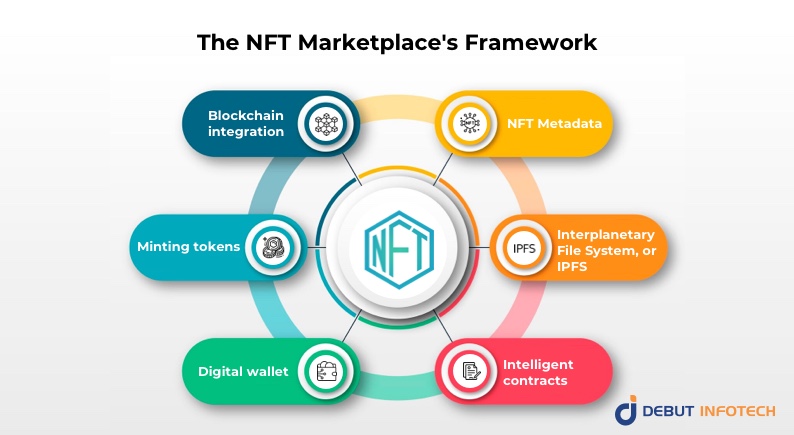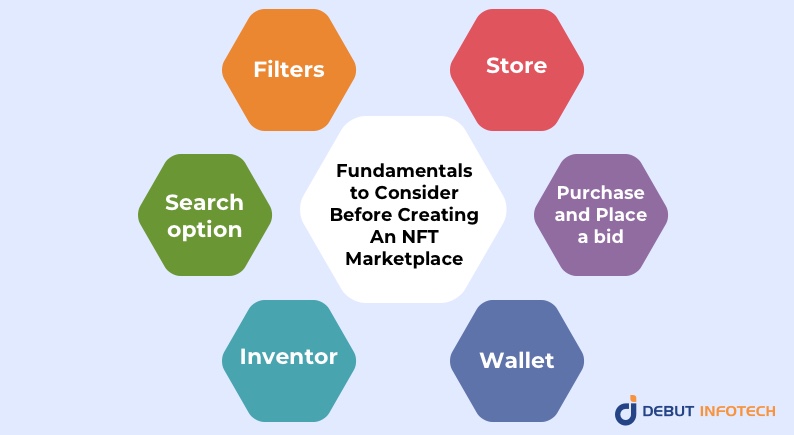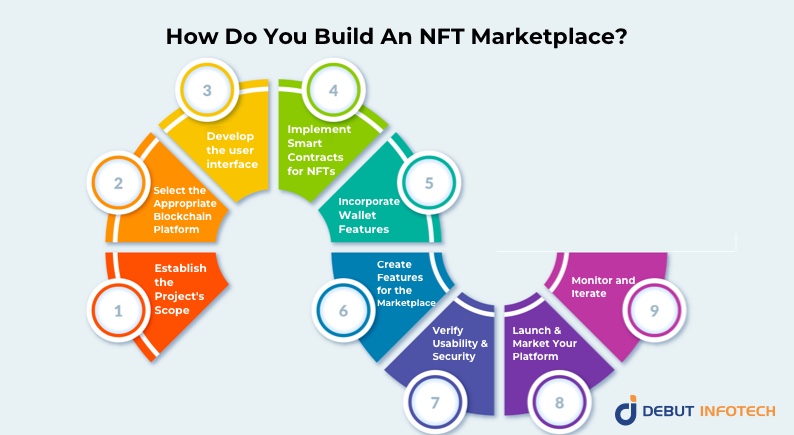Table of Contents
Home / Blog / NFT Marketplace
Developing An NFT Marketplace Platform: All You Need To Know
March 19, 2024

March 19, 2024
The advanced use cases of blockchain technology, such as NFTs, are significant in its expanding popularity and industry acceptance. Non-fungible tokens, or NFTs, have been increasingly popular in recent years, revolutionizing digital asset purchasing, selling, and trading.
NFTs are immutable digital asset ownership records based on blockchain technology that offer real value. They exhibit benefits in a variety of ways. The strength and promise of NFTs have greatly benefited various industries, including entertainment, gaming, music, and the arts.
The security provided by blockchain technology makes NFT-based digital assets increasingly dependable, as it removes concerns about copyright infringement. NFT marketplace development is in greater demand as NFT creators and traders participate in NFT creation and trading. Users can easily list and purchase NFT assets on an NFT marketplace platform development without taking on any risk or involving a third party. Entrepreneurs see this as a chance to grow this new technology into a significant industry. A thorough guide is given for individuals interested in how to create NFT marketplace.
What Are NFT Marketplaces?
The NFT marketplace is a decentralized place that is characterized by users who can create, buy, sell, and hold non-fungible tokens. The NFT can be minted and traded in the NFT marketplace and presented by the blockchain as its underlying technology for providing transparency and immutability of the tokenization and changes of digital assets. The market additionally provides NFT storage services.
NFT markets are driving almost every market that deals in digital goods, ranging from gaming to art, music, and social networking. The growth of the NFT marketplaces has become even more prominent and widespread since the Metaverse projects started.
NFT marketplace features have been improving with each passing day and issues like their lack of interoperability are being addressed The most modern NFT marketplaces possess the advanced features, such as cross-chain bridging, niche-specific NFTs, NFT swapping, and possible interoperability with many metaverse projects.
The niche is a critical factor to consider before starting with creating NFT marketplace platform. Moving beyond niche, it is important to remember a number of other factors, including the choice of a blockchain protocol, storing NFT, architecture, and more. This narrative dissects the evolution of the NFT marketplace from the angle of every conceivable part.
The NFT Marketplace’s Framework

Maintaining consistency and providing a simple interface for new and returning consumers is crucial while creating an NFT marketplace. An NFT marketplace’s architectural elements must comprise IPFS, wallets, smart contracts, and a blockchain, which will serve as the platform’s operating system.
Blockchain integration
You can use many blockchain networks to create a fully operational NFT marketplace. These comprise blockchain networks that are hybrid, private, consortium, and public. The technology aids in the archiving of data on NFTs and platform transactions.
Minting tokens
Whether or not gas costs are included in the NFT program, Minting NFTs is crucial. The procedure generates a new block, registers it into the blockchain, and verifies the collected data.
Digital wallet
A digital wallet is an electronic wallet that allows users to store digital currency. Additionally, it permits the purchase and sale of NFT assets.
NFT Metadata
It explains the NFT assets that are kept on the market. Its name, creation date and time, qualities, actual owner, and so forth may all be included in the description.
Interplanetary File System, or IPFS
An alternative to the energy-intensive blockchain storage of digital assets with metadata is IPFS, a data storage system.
Intelligent contracts
An NFT marketplace uses smart contracts to give each NFT a distinct identity. To distinguish non-fungible tokens from fungible crypto tokens, it uses the ERC-721 standard.
Now, let’s see how an NFT marketplace works.
How An NFT Marketplace Works
Just like any traditional retail outlet, there’s a fundamental need for a dedicated hub to house, trade, and purchase NFTs. In addition to storing NFT assets, an NFT marketplace combines an intuitive user interface with highly potent backend features that facilitate the underlying blockchain technology.
Both creators and collectors of NFTs are important to an NFT marketplace’s operation. Generally, similar work processes are found in all NFT platforms. Users must sign up on the website first and get a digital wallet to keep their NFTs.
Next, users can upload assets to display their creations and create their own materials. Users can also choose their fee based on what the platform suggests and select which form of payment they’d like for their art. The procedure then shifts to selling the items. The user can choose to auction or set a price. When the item goes up for sale, the user’s wallet starts a personal trade smart contract.
Approved NFTs will be added to the list, albeit the platform may require collecting moderation.
Fundamentals to Consider Before Creating An NFT Marketplace

Knowing the types of platforms available and how NFT marketplaces operate will help you build your platform, but you also need to know for whom and what problems it may be used.
Some essential features that can be added to an NFT marketplace are listed below.
- Filters
It is easier to traverse a website when you use filters, especially if you intend to create a marketplace for many collectibles. Users can choose goods based on payment method, listing status, category, and collection when the filters feature is added.
- Search option
For consumers to be able to search for collectibles, an NFT marketplace platform needs to provide labelling and category management. Utilize the website’s search bar and add categories.
- Inventory
It should be possible for users to make and submit collectibles. Using this function, a user can upload files and enter token data, including name, tags, and description.
- Store
A storefront in the NFT marketplace should provide users with all the information they need to know about an item, including bids, owners, previews, and price history.
- Purchase and Place a bid
Users should be able to purchase and place bids on NFTs posted on the NFT marketplace platform. They should also be able to read information about the current status of bids and the feature that allows bidding to add a bid expiration date.
- Wallet
Non-fungible tokens should be able to be sent, stored, and received using a wallet on the NFT Marketplace Platform. Giving consumers a connected wallet they already use is the most straightforward approach to incorporate this capability. One option is integrating well-known wallets such as Coinbase, Formatic, or MyEtherWallet.
The NFT Marketplace’s Technological Stack

Blockchain Platforms
Ethereum
One of the most often used platforms for the construction of non-fungible tokens or NFT marketplaces is Ethereum. The public verifiability of transaction history and token metadata on Ethereum makes ownership history verification easy. Since every Ethereum product has an identical backend, NFTs become cross-product transferable. Furthermore, token sales will always be possible because Ethereum rarely experiences outages.
Flow
A fast and decentralized blockchain, Flow is made for the next generation of digital goods, games, and apps. The Cadence programming language is commonly used to develop NFTs and NFT marketplaces on the platform.
Tezos
Supported by a community of developers, researchers, and validators, Tezos is an open-source blockchain platform for assets and applications. Tezos facilitates the creation of NFT marketplaces and NFTs using a pre-compiled FA2 NFT contract written in LIGO smart contract language.
Cardano
Cardano is a blockchain platform with the tools and technologies needed to give decentralized systems and apps the highest level of sustainability and security. It additionally aids in the creation of NFTs and other digital assets.
Storage Platforms
IPFS
A peer-to-peer hypermedia protocol called IPFS was created with decentralized media content storage in mind. IPFS can hold all that data since the media file associated with NFTs cannot be kept directly on the blockchain.
Filecoin
Filecoin is a decentralized network that stores essential data, including media files. Everything a developer needs to get started with decentralized storage for NFTs is included in the storage platform. Aware of its advantages, Truffle Suite has also introduced the NFT Development Template in conjunction with Filecoin Box.
Pinata
Another well-liked platform for IPFS file management and uploading is called Pinata. It offers NFT files that are safe and able to be verified.
NFT Standards
ERC-721
ERC-1155
FA2
dGoods
TRC-721
Front-end Frameworks
React
Angular
Vue
How Do You Build An NFT Marketplace?

An NFT marketplace platform must be carefully planned, technically sound, and meticulously executed. To create your own NFT marketplace platform, adhere to the following steps:
1. Establish the Project’s Scope: Establish the goal and parameters of your NFT marketplace platform first. Establish your target market, essential features, and the kinds of NFTs you wish to support (art, collectibles, virtual real estate, etc.).
2. Select the Appropriate Blockchain Platform: Choose a blockchain platform that works well for your NFT marketplace. Although Ethereum is the most widely used option, other options, such as Flow and Binance Smart Chain, are also worth consideration. Consider elements like community support, scalability, and transaction fees.
3. Develop the user interface: Design an intuitive user experience so that people can easily explore, purchase, sell, and exchange NFTs. Consider features like responsive design, eye-catching graphics, and simple navigation for smooth device access.
4. Implement Smart Contracts for NFTs: Develop and deploy smart contracts to represent and manage NFTs on the blockchain. Each NFT’s ownership, transferability, and information should be specified in these contracts. When considering standards for interoperability with current wallets and marketplaces, consider ERC-721 or ERC-1155.
5. Incorporate Wallet Features: Provide customers with the opportunity to buy, sell and store NFTs by letting them integrate their crypto wallets with your platform. Adopt well-known wallet services such as Trust Wallet or MetaMask to store your transactions and keep private keys safely.
6. Create Features for the Marketplace: Create a simple interface, like user profiles, NFT listing, search and filtering options, bidding and auction options, and transaction history monitoring. To enhance user engagement, consider adding social capabilities like sharing, following, and commenting.
7. Verify Usability and Security: Be sure that the platform you have developed is secure and easy to use by testing it completely. Check the vulnerabilities of the smart contracts, do load testing to find scalability, and get feedback from beta testers to identify bugs or usability problems.
8. Launch and Market Your Platform: Make your NFT Marketplace Platform live after testing, and then open it to everyone. Marketing it on several channels, including social media, influencer collaborations, and targeted advertising, can bring in consumers and producers.
9. Monitor and Iterate: Ensure that you keep an eye on the metrics that reveal the platform’s performance to identify possible areas for improvement and get user feedback. The stability you get when creating your NFT marketplace platform must be maintained in the long run by constantly updating your current feature set, troubleshooting any problems that might arise, and staying on track with the latest trends.
These techniques will help you create a successful NFT marketplace platform that draws both users and creators as long as you remain dedicated to providing an excellent user experience.
How Does Debut Infotech Come In?
Debut Infotech is a blockchain development business that provides customized solutions for NFT marketplace creation. They assist clients from conception to implementation, leveraging their knowledge of decentralized applications and blockchain technology. Their knowledgeable staff guarantees safe and scalable systems with their expertise in wallet integration, smart contract implementation, and user-friendly design. Debut Infotech enables companies to develop successful NFT markets by providing innovative solutions.
Conclusion
Any developer or corporation may build a feature-rich, fully working NFT marketplace where NFTs can be easily bought and sold by following these easy steps.
There is an increasing demand for NFT marketplaces due to the popularity of NFTs. This will make storing these digital assets possible and increasing their accessibility for simple purchasing and selling. It is possible to argue that the development of the NFT marketplace will play a significant role in the expansion and prosperity of the blockchain sector.
FAQS
Q. What is an NFT marketplace platform?
A. An NFT platform is an online marketplace where users exchange and purchase non-fungible tokens (NFTs) representing tangible or intangible goods like virtual real estate, artwork, and collectibles.
Q. How can I create a NFT marketplace like opensea?
A. An NFT marketplace platform’s development process includes specifying the project’s parameters, picking the best blockchain platform, developing the user interface, putting smart contracts into place, incorporating wallet features, and testing the system for usability and security.
Q. Is blockchain technology knowledge required to create an NFT marketplace platform?
A. While having a deep understanding of blockchain technology is not a must, working with blockchain development companies like Debut Infotech can assist with integrating blockchain capabilities and implementing smart contracts, which is crucial to building an NFT marketplace platform.
Q. How can I monetize my NFT marketplace platform?
A. NFT marketplace platforms may make money via transaction fees, premium listing fees, and chances for sponsorship and advertising. These premium memberships are based on subscriptions, special perks, and partnerships with producers and artists.
Q. Which characteristics make an NFT marketplace platform successful?
A. A successful NFT marketplace platform will include an easy-to-use interface, seamless connection with blockchain networks, support for multiple NFTs, secure wallet integration, powerful search and filtering options, transparent transaction history, and community participation elements.
Talk With Our Expert
Our Latest Insights
USA
2102 Linden LN, Palatine, IL 60067
+1-708-515-4004
info@debutinfotech.com
UK
Debut Infotech Pvt Ltd
7 Pound Close, Yarnton, Oxfordshire, OX51QG
+44-770-304-0079
info@debutinfotech.com
Canada
Debut Infotech Pvt Ltd
326 Parkvale Drive, Kitchener, ON N2R1Y7
+1-708-515-4004
info@debutinfotech.com
INDIA
Debut Infotech Pvt Ltd
Sector 101-A, Plot No: I-42, IT City Rd, JLPL Industrial Area, Mohali, PB 140306
9888402396
info@debutinfotech.com




Leave a Comment